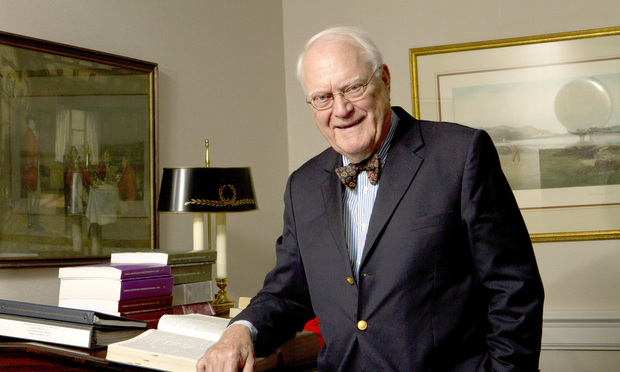Federal Court Delivers Massive Blow to Big Tobacco on Yearslong Challenge
The 45-page ruling was a study in litigation nuances arising from the Engle class action.
March 08, 2018 at 03:50 PM
5 minute read
The original version of this story was published on Daily Business Review

A federal appellate court thwarted efforts by tobacco companies to overturn a multimillion-dollar judgment against them, while pointing to the “unique and difficult challenge” Florida Supreme Court's Engle ruling created for courts and juries.
The U.S. Court of Appeals for the Eleventh Circuit shut down a multi-prong challenge by R.J. Reynolds Tobacco Co. and Philip Morris USA Inc., which sought to overturn $7.5 million in compensatory and punitive damages for plaintiff Pauline Burkhart.
The case involved a call for a mistrial after a dramatic courtroom occurrence that the defense said prejudiced the jury. About 20 minutes into the third day of trial, Burkhart “suffered a medical incident” in which she reportedly “continued crying out in pain for 20 or 30 seconds or perhaps a minute” before jurors. The judge denied a motion to grant a mistrial, prompting the companies to allege abuse of discretion.
The federal appellate court affirmed, ruling in Burkhart's favor, but its 45-page ruling was a study in litigation nuances arising from the Engle class action. It delved into how district court judges, presiding over the thousands of cases that followed, have had to wrangle with the fallout from a case that required jurors to accept numerous previous blanket legal findings, while also weighing each suit's unique facts.
The landmark Engle decision stemmed from a 1994 Florida suit by six lung cancer patients accusing major U.S. country's major cigarette manufacturers of fraud, negligence, intentional infliction of emotional distress, breach of express warranty, strict liability, conspiracy to commit fraud and breach of implied warranty.
A Miami-Dade Circuit Court judge divided the case into three phases: The first resulted in a jury finding the tobacco companies' conduct entitled the class to punitive damages. The second awarded compensatory damages and also set a $145 billion punitive damages award for the entire class. But an appeal by the defendants disrupted the third phase, which would have asked to set “specific causation and damages for the remaining class members in Phase III.”
In a win for the defense, the Florida Supreme Court found class certification inapplicable, saying findings would hinge on each plaintiff's comparative fault, legal causation and other individual circumstances. But the high court also upheld much of the jury's Phase I findings—that the companies' behavior entitled the class to punitive damages—except “on the fraud and intentional infliction of emotional distress claims, which involved highly individualized determinations, and the finding on entitlement to punitive damages questions, which was premature.”
The Florida Supreme Court ruled that individual plaintiffs could bring their own suits, and that the “retained findings” would apply under the res judicata doctrine that prevents the relitigation of adjudicated claims between the same parties. The class-wide punitive damages award was vacated.
In the thousands of cases that followed, jurors had to uphold the Engle findings and go into deliberations accepting the tobacco companies committed multiple torts, including civil-conspiracy concealment, breach of implied warranty, fraud by concealment, breach of express warranty, strict liability and negligence. However, these jurors also had to weigh case-specific elements to determine whether addiction caused each plaintiff's disease. And in considering fraudulent-concealment and conspiracy claims, they had to evaluate whether each plaintiff relied on the companies' misrepresentations.
“Thus, the Phase I jury 'did not determine whether the defendants were liable to anyone,' ” Eleventh Circuit Judge Gerald Bard Tjoflat wrote in a unanimous decision with Judge Frank M. Hull and Senior U.S. District Judge Harvey Bartle III, sitting by special designation. “ Nor could Engle establish the tobacco companies' liability for purposes of awarding punitive damages.”
A key disparity: The Engle case established the cigarette companies met Florida's statutory definition of “intentional misconduct” by concealing and conspiring to withhold information about the dangers of smoking. But it never established the companies had “actual knowledge of the wrongfulness of their conduct and nevertheless intentionally pursued that conduct,” according the appellate court ruling.
Details in the Eleventh Circuit ruling show this issue was at the heart of the the Burkhart case, which was pending for years while awaiting the outcome of other Engle progeny appeals before federal panels and in Florida's high court. They point to defense claims that the district judge's interjections at trial reflected “a fundamental misunderstanding of the role of the Engle findings” and prevented the companies from opposing Burkhart's request for punitive damages.
But the appellate court disagreed and upheld the trial outcome.
“The district court (judge) was concerned that (tobacco companies) counsel blurred the distinction between arguing that appellants did not have knowledge of the wrongfulness of their conduct—for purposes of awarding punitive damages—and that they did not conceal information or conspire to conceal information at all—for purposes of awarding compensatory damages under Burkhart's intentional tort claims,” Tjoflat wrote. “On each occasion in which the district court interrupted, the court did so to clarify to the jury that Appellants could not challenge the Engle findings on concealment, because R.J. Reynolds' counsel framed his argument as challenging whether concealment ever occurred at all.”
This content has been archived. It is available through our partners, LexisNexis® and Bloomberg Law.
To view this content, please continue to their sites.
Not a Lexis Subscriber?
Subscribe Now
Not a Bloomberg Law Subscriber?
Subscribe Now
NOT FOR REPRINT
© 2025 ALM Global, LLC, All Rights Reserved. Request academic re-use from www.copyright.com. All other uses, submit a request to [email protected]. For more information visit Asset & Logo Licensing.
You Might Like
View All
An ‘Indiana Jones Moment’: Mayer Brown’s John Nadolenco and Kelly Kramer on the 10-Year Legal Saga of the Bahia Emerald


Travis Lenkner Returns to Burford Capital With an Eye on Future Growth Opportunities

Legal Speak's 'Sidebar With Saul' Part V: Strange Days of Trump Trial Culminate in Historic Verdict
1 minute readTrending Stories
Who Got The Work
J. Brugh Lower of Gibbons has entered an appearance for industrial equipment supplier Devco Corporation in a pending trademark infringement lawsuit. The suit, accusing the defendant of selling knock-off Graco products, was filed Dec. 18 in New Jersey District Court by Rivkin Radler on behalf of Graco Inc. and Graco Minnesota. The case, assigned to U.S. District Judge Zahid N. Quraishi, is 3:24-cv-11294, Graco Inc. et al v. Devco Corporation.
Who Got The Work
Rebecca Maller-Stein and Kent A. Yalowitz of Arnold & Porter Kaye Scholer have entered their appearances for Hanaco Venture Capital and its executives, Lior Prosor and David Frankel, in a pending securities lawsuit. The action, filed on Dec. 24 in New York Southern District Court by Zell, Aron & Co. on behalf of Goldeneye Advisors, accuses the defendants of negligently and fraudulently managing the plaintiff's $1 million investment. The case, assigned to U.S. District Judge Vernon S. Broderick, is 1:24-cv-09918, Goldeneye Advisors, LLC v. Hanaco Venture Capital, Ltd. et al.
Who Got The Work
Attorneys from A&O Shearman has stepped in as defense counsel for Toronto-Dominion Bank and other defendants in a pending securities class action. The suit, filed Dec. 11 in New York Southern District Court by Bleichmar Fonti & Auld, accuses the defendants of concealing the bank's 'pervasive' deficiencies in regards to its compliance with the Bank Secrecy Act and the quality of its anti-money laundering controls. The case, assigned to U.S. District Judge Arun Subramanian, is 1:24-cv-09445, Gonzalez v. The Toronto-Dominion Bank et al.
Who Got The Work
Crown Castle International, a Pennsylvania company providing shared communications infrastructure, has turned to Luke D. Wolf of Gordon Rees Scully Mansukhani to fend off a pending breach-of-contract lawsuit. The court action, filed Nov. 25 in Michigan Eastern District Court by Hooper Hathaway PC on behalf of The Town Residences LLC, accuses Crown Castle of failing to transfer approximately $30,000 in utility payments from T-Mobile in breach of a roof-top lease and assignment agreement. The case, assigned to U.S. District Judge Susan K. Declercq, is 2:24-cv-13131, The Town Residences LLC v. T-Mobile US, Inc. et al.
Who Got The Work
Wilfred P. Coronato and Daniel M. Schwartz of McCarter & English have stepped in as defense counsel to Electrolux Home Products Inc. in a pending product liability lawsuit. The court action, filed Nov. 26 in New York Eastern District Court by Poulos Lopiccolo PC and Nagel Rice LLP on behalf of David Stern, alleges that the defendant's refrigerators’ drawers and shelving repeatedly break and fall apart within months after purchase. The case, assigned to U.S. District Judge Joan M. Azrack, is 2:24-cv-08204, Stern v. Electrolux Home Products, Inc.
Featured Firms
Law Offices of Gary Martin Hays & Associates, P.C.
(470) 294-1674
Law Offices of Mark E. Salomone
(857) 444-6468
Smith & Hassler
(713) 739-1250






